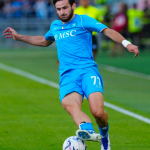
Why the Napoli fans are protesting
Despite the wonderful season, the fans have something to complain about
April 5th, 2023
Serie A is coming to an end, after the break for national teams from April to June, every weekend will be on the pitch. Napoli is now plus 16 behind second-placed Lazio and seems to be able to sleep soundly while waiting for mathematical certainty. Meanwhile in the city, as in the newspapers and online, there is nothing but celebration for Spalletti's eleven. The Napoli coach has succeeded in moulding his players in the best possible way, winning important points on Italian and European pitches. In the meantime, the city, together with the neighbouring municipalities, is painted blue, giving free rein to everyone's creativity with special cakes, blue-coloured sandwiches and streets filled with players' cartoons.
Yet if at first glance everything seems to be in place, not all that glitters is gold. Remaining in the sporting sphere, without digressing into extra-football matters, there is one major void: the fans at the Diego Armando Maradona stadium. Ever since the Fuorigrotta stadium was renamed in honour of the Argentinean footballer, it has never reached the warmth of the past, amid faded seats, flags and drums. The organised fans, in fact, are the protagonists of a strong clash with the club, an issue that has been going on for a long time, since Ancelotti's time, they have tried to impose themselves several times by clamouring for changes to the stadium regulations. First with the fines for the allocation of seats, especially in the centre of the popular sector, and then this season with the ban on drums, megaphones and flags, the situation has been getting worse and worse, until reaching a definitive breaking point.
Only in a few matches did the two sides manage to find a balance, but they did not provide the necessary continuity to create the festive atmosphere that is felt in the city. The climax was reached in recent months in the home matches against Lazio and AC Milan, in a stadium-theatre in which the visiting fans with their flags, drums and in the case of the Lazio fans also bombs and smoke bombs were the stars. The demand is simple: to bring the euphoria that sweeps the city far and wide into their temple, also demanding a different pricing policy, differentiating at least the upper and lower sectors (where the view is clearly worse).
Precisely for this reason, on Sunday 2 April, the groups from Curve A and Curve B met near the Maradona to make their voices heard, gathering a large number of fans ready to sing and colour the entire area blue, clamouring for a change in a regulation that has become stringent and unhelpful for the Neapolitans' moment. And after a completely blue afternoon, amidst chants and hugs, at the stadium, however, something quite different happened. On the pitch, Spalletti's team played their worst performance, against a strong Milan side proud of the Scudetto they won last year. The same pride that the Rossoneri fans brought to the guest sector.
On the Azzurri side, the tension was palpable. Just before the kick-off, the first choruses against the club started from the B side, to which the stands and the tribunes responded with whistles. The same areas, however, that at 4-0 were already half-empty. This same tension, unfortunately, also led to internal clashes between some groups of the Curva B, which ended in less than a minute, giving way then to chants and euphoria coming from the visiting sector. This protest continued throughout the match, with chants and smoke bombs being thrown in defiance towards the end of the match, and was joined by the guest sector, which was strong with the lead and the crucial three points in their pockets.
A situation that not only the Neapolitan public live with, even the Juventus organised groups are forced to respect the same restrictions, something that could potentially happen in all stadiums with clubs dreaming of atmospheres and curves like in La Liga and the Premier League, with a gentrification of the fans. Something surreal for a team that is about to return to victory after more than 30 years, and also given that at the beginning of the year the issue seemed to have been shelved, with fans ready to support their team, as it always has been. It all came back to the surface, especially after the clashes with Romanisti on the motorway, which brought back the usual rhetoric about organised supporters, guilty of creating public order problems and more. An issue that has also been inflamed by the prices reserved for the Champions League match against AC Milan, where the much-acclaimed popular prices will stand at 300 euros in total if a parent wants to bring their child to the stadium, in a sector where visibility is very limited.
Beyond everyone's legitimate opinions, there is only one reality: the decision was made to give up a legendary fan base, which has also made the club's fortune, to the detriment of an atmosphere that can instead be found in all the other stadiums in Italy (such as Bari, also owned by the De Laurentiis family), where the club and organised fans find the right compromise for the good of all. To date, this division is undoubtedly paradoxical, the climax of a season as historic as it is epic, which hopefully will resolve itself as in the best of happy endings. A bad showcase for Napoli, from every point of view, since the passion of the Parthenopeans has always been something distinctive, but the climate in the stadium is now in danger of changing forever.












